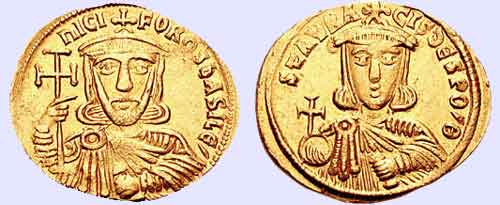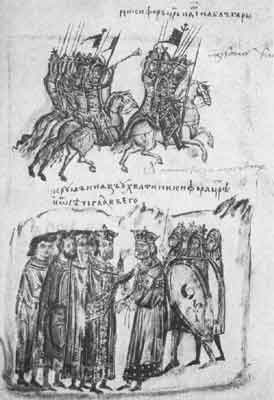.

Nikephoros I and his son and successor, Staurakios. Image: http://www.cngcoins.com
Nikephoros I or Nicephorus I, Logothetes or Genikos (Greek: Νικηφόρος Α΄, Nikēphoros I, "Bringer of Victory"), (died July 26, 811) was Byzantine emperor from 802 to 811, when he was killed in the disastrous Battle of Pliska.
A patrician from Seleucia Sidera, Nikephoros was appointed finance minister (logothetēs tou genikou) by the Empress Irene. With the help of the patricians and eunuchs he contrived to dethrone and exile Irene, and to be chosen emperor in her stead on October 31, 802. He crowned his son Staurakios co-emperor in 803.
His rule was endangered by Bardanes Tourkos, one of his ablest generals, who revolted and received support from other commanders, notably the later emperors Leo V the Armenian and Michael II the Amorian in 803.
But Nikephoros gained over the latter two, and by inducing the rebel army to disperse achieved the submission of Bardanes, who was relegated to a monastery. A conspiracy headed by the patrician Arsaber had a similar issue.
Nikephoros embarked on a general reorganization of the empire, creating new themes in the Balkans (where he initiated the re-Hellenization by resettling Anatolian populations) and strengthening the frontiers. Needing large sums to increase his military forces, set himself with great energy to increase the empire's revenue. By his rigorous tax imposts he alienated the favour of his subjects, and especially of the clergy, whom he otherwise sought to control firmly. Although he appointed an iconodule, Nikephoros as patriarch, Emperor Nikephoros was portrayed as a villain by ecclesiastical historians like Theophanes the Confessor.
In 803 Nikephoros concluded a treaty, called the Pax Nicephori, with Charlemagne, but refused to recognize the latter's imperial dignity. Relations deteriorated and led to a war over Venice in 806–810. In the process Nikephoros had quelled a Venetian rebellion in 807, but suffered extensive losses to the Franks. The conflict was resolved only after Nikephoros' death, and Venice, Istria, the Dalmatian coast and South Italy were assigned to the East, while Rome, Ravenna and the Pentapolis were included in the Western realm.
By withholding the tribute which Irene had agreed to pay to the caliph Hārūn al-Rashīd, Nikephoros committed himself to a war against the Arabs. Compelled by Bardanes' disloyalty to take the field himself, he sustained a severe defeat at Krasos in Phrygia (805), and the subsequent inroads of the enemy into Asia Minor induced him to make peace on condition of paying a yearly tribute of 30,000 gold pieces. With a succession struggle enveloping the caliphate on the death of Hārūn al-Rashīd in 809, Nikephoros was free to deal with Krum of Bulgaria, who was harassing his northern frontiers and had just conquered Serdica (Sofia).
In 811 Nikephoros invaded Bulgaria, defeated Krum twice, and sacked the Bulgarian capital Pliska. However, during Nikephoros' retreat, the Byzantine army was ambushed and destroyed in the mountain passes on July 26. Nikephoros was killed in the battle, the second Roman emperor to suffer this fate since Valens in the Battle of Adrianople (August 9, 378). Krum is said to have made a drinking-cup of Nikephoros' skull.

Nikephoros, 811 AD, Constantine Manasses Chronicle 1345 Manuscript
Family
By an unknown wife Nikephoros I had at least two children:
- Staurakios, who succeeded as emperor.
- Prokopia, who married Michael I Rangabe, emperor since 811.
Preceded by: Irene
Succeeded by: Staurakios
References
- The Oxford Dictionary of Byzantium, ed. by Alexander Kazhdan, Oxford University Press, 1991.
- This article incorporates text from the Encyclopædia Britannica Eleventh Edition, a publication now in the public domain.
| Ancient Greece
Science, Technology , Medicine , Warfare, , Biographies , Life , Cities/Places/Maps , Arts , Literature , Philosophy ,Olympics, Mythology , History , Images Medieval Greece / Byzantine Empire Science, Technology, Arts, , Warfare , Literature, Biographies, Icons, History Modern Greece Cities, Islands, Regions, Fauna/Flora ,Biographies , History , Warfare, Science/Technology, Literature, Music , Arts , Film/Actors , Sport , Fashion --- |
Retrieved from "http://en.wikipedia.org"
All text is available under the terms of the GNU Free Documentation License

